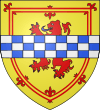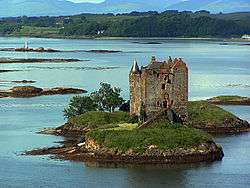Clan Stewart
| Clan Stewart | |||
|---|---|---|---|
| Stiùbhard[1] | |||
 Crest: Due to a lack of a chief, members sometimes use the badge belonging to the Earl of Galloway. A pelican Argent, winged Or, in her nest feeding her young, Proper. | |||
| Motto | Virescit vulnere virtus (Courage grows strong at a wound)[1] | ||
| Profile | |||
| Region | Lowlands and Highlands | ||
| District | Renfrewshire, Teviotdale and Lauderdale. | ||
| Plant badge | Thistle[1] | ||
| Pipe music | Bratach Bhan nan Stiubhartach (The white banner of the Stewarts)[1] | ||
 | |||
| Clan Stewart has no chief, and is an armigerous clan | |||
| Commander | The Earl of Galloway is considered to be the senior cadet, but is not chief. The senior cadet is Randolph Stewart, 13th Earl of Galloway. | ||
| |||
| |||
| |||
| |||
Clan Stewart (Gaelic: Stiùbhard) is a Highland Scottish clan. The clan is recognised by Court of the Lord Lyon, however it does not have a clan chief recognised by the Lord Lyon King of Arms. Because the clan has no chief it can be considered an armigerous clan; however the Earls of Galloway are now considered to be the principal branch of this clan,[2] and the crest and motto of The Earls of Galloway's arms are used in the Clan Stewart crest badge. The Court of the Lord Lyon recognises two other 'Stewart' clans, Clan Stuart of Bute and Clan Stewart of Appin. Clan Stuart of Bute is the only 'Stewart' clan at present which has a recognised chief.[3]
History
Origins of the clan
The Stewarts who became monarchs of Scotland were descended from a family who were seneschals of Dol in Brittany, France.[4] After the Norman conquest of England the Stewarts acquired estates in England as the FitzAlan family, also Earls of Arundel.[4] Walter Flaad or Walter fitz Alan, the Steward came to Scotland when David I of Scotland claimed his throne.[4] It is from their office as Stewards that the surname Stewart came from.[5] Walter was created High Steward of Scotland and was granted large estates in Renfrewshire and East Lothian.[4] Walter was one of the commanders of the royal army which defeated Somerled of the Isles (ancestor of Clan Donald) at the Battle of Renfrew in 1164.[4] (See: Walter fitz Alan).
Wars of Scottish Independence
During the Wars of Scottish Independence, James Stewart, 5th High Steward of Scotland swore fealty to Edward I of England.[4] However he later sided with Robert the Bruce and William Wallace in the struggle for Scottish independence.[4]
Royal House of Stewart
Walter Stewart, 6th High Steward of Scotland married Marjory, daughter of king Robert the Bruce.[4] When Robert's son, David II of Scotland died, he was succeeded by Walter Stewart's son, Robert II of Scotland.[4] King Robert II had many sons, the eldest, John, succeeded to the throne of Scotland as Robert III of Scotland.[4] The royal line of male Stewarts was uninterrupted until the reign of Mary, Queen of Scots.[4] As a family the Stewarts (Stuarts) held the throne of Scotland and later England until the death of Anne, Queen of Great Britain in 1714.[4]
Albany Stewarts
The Dukedom of Albany is a peerage title that was bestowed on some younger sons in the Scottish and later the British royal family, particularly in the House of Stuart. Robert II's third son was Robert Stewart, 1st Duke of Albany, who was Regent of Scotland during part of the reigns of his father, brother, and nephew James I of Scotland.[4] Robert II's fourth son was Alexander Stewart, Earl of Buchan, who was famed as the Wolf of Badenoch and was responsible for the destruction of Elgin Cathedral.[4]
 |
 |
.svg.png) |
|---|---|---|
.svg.png) |
_(Ecosse).svg.png) |
.svg.png) |
.svg.png) |
 |
.svg.png) |
_Duc_d'Albany.svg.png) |
.svg.png) |
 |
_(1337_1406).svg.png) |
 |
_comte_de_Strathearn_et_de_Caithness.svg.png) |
 |
 |
_1er_Comte_de_Lennox_(1473_-_2e_cr%C3%A9ation).svg.png) |
 |
_Lord_Avandale.svg.png) |
 |
When James I of Scotland came of age, he curbed the power of his cousins, the Albany Stewarts.[4] He beheaded Murdoch Stewart, 2nd Duke of Albany, eldest son of the former regent Robert Stewart.[4] Two of Murdoch's sons, Walter and Alexander (Alasdair), were both executed as well.[6][7]
Main branches of the clan
Apart from the royal house of Stewart, the three main branches of the clan that settled in the Scottish Highlands during the 14th and 15th centuries were the Stewarts of Appin, Stewarts of Atholl and Stewarts of Balquhidder.[4] Today the Earls of Galloway are considered the senior line of the Clan Stewart.[4]
Stewarts of Appin
The Stewarts of Appin descend from Sir John Stewart of Bonkyl, son of Alexander Stewart, 4th High Steward of Scotland.[4] Sir John's younger son, James Stewart, was killed in 1333 at the Battle of Halidon Hill.[4] His grandson married the heiress of the Lord of Lorne (chief of Clan MacDougall).[4] He was the first Stewart Lord of Lorne.[4] The Stewarts of Appin supported the royalist cause during the Civil War of the 17th century and also supported the deposed Stuart monarchs during the Jacobite rising of 1715 and Jacobite rising of 1745.[4]
Stewarts of Atholl
The Stewarts of Atholl are descended from a son of Alexander Stewart, Earl of Buchan (the Wolf of Badenoch).[4] James Stewart built a strong castle at Garth where he settled at the end of the 14th century.[4] Queen Joanna, widow of James I of Scotland married the Black Knight of Lorne who was descended from the fourth High Steward.[4] Their son was John Stewart of Balveny who was granted the Earldom of Atholl by his half-brother, James II of Scotland.[4] He supported his brother, commanding the royal forces that opposed the rebellion by the Lord of the Isles.[4] The fifth Stewart Earl of Atholl died with no male issue and his daughter married William Murray, second Earl of Tullibardine, who succeeded as Earl of Atholl.[4] Many Stewarts continued to live in the Atholl area with many claiming descent from the Wolf of Badenoch.[4] They were mainly transferred by allegiance to the Murray Earls of Atholl and were known as Atholl men.[4] This is maintained today with the Atholl Highlanders, Europe's only legal private army.[4] General David Stewart of Garth, an Athollman, was an officer in the Black Watch regiment and his book, Sketches of the Highlanders and Highland Regiments, popularized his homeland in Victorian England.[4]
Stewarts of Balquhidder
Stewarts came to Balqhidder in about 1490 when William Stewart, grandson of the only son of the Duke of Albany to escape the persecution of James I, was appointed ballie of the Crown lands of Balquhidder.[4]
Stuarts of Bute
The chiefs of the Clan Stuart of Bute are descended from John, younger son of Robert Stewart who reigned as Robert II of Scotland.[8]
Castles

.jpg)
- Edinburgh Castle one of the most notable castles owned by the Stewarts as the royal family.
- Stirling Castle one of the most notable castles owned by the Stewarts as the royal family.
- Linlithgow Palace was one of the principal residences of the Stewart and Stuart monarchs of Scotland.
- Falkland Palace was acquired by the Stewart family in the 14th century and was owned by Robert Stewart, Duke of Albany. It was a royal palace of the Scottish kings.
- Castle Stuart was the home of the line of Stuarts who held the title Earl of Moray.
- Castle Stalker was a seat of the Stewarts of Appin.
- Lochranza Castle was granted to Walter Stewart, 6th High Steward of Scotland in 1262 by Alexander III of Scotland.
- Dundonald Castle built in the 13th century by Alexander Stewart, 4th High Steward of Scotland. Used by the Stewart monarchs.
- Craigmillar Castle, Edinburgh, castle of the royal Stuarts.
- Doune Castle built in the 14th century by Robert Stewart, Duke of Albany.
- Earl's Palace, Kirkwall built by Robert Stewart, 1st Earl of Orkney.
- Bishop's Palace, Kirkwall originally a Norwegian fort, ownership later passed to Robert Stewart, 1st Earl of Orkney.
- Scalloway Castle built by Patrick Stewart, 2nd Earl of Orkney.
- Earl's Palace, Birsay built by Patrick Stewart, 2nd Earl of Orkney.
- Crookston Castle has been owned by various branches of the Clan Stewart.
- Rothesay Castle was built by the Stewarts at the beginning of the 13th century.
- Drumin Castle was the home of Alexander Stewart, Earl of Buchan (the Wolf of Badenoch).
- Ardvorlich Castle, stronghold of the Stuarts of Balquhidder
- Garth Castle, stronghold of the Clan Stewart.
- Grandtully Castle, stronghold of the Clan Stewart.
- Garlies Castle, stronghold of the Clan Stewart.
- Castle Campbell, originally called Castle Gloom, it passed by right of marriage to the Campbells who changed the name to Castle Campbell by an Act of Parliament in 1489.
Tartans
| Tartan image | Notes |
|---|---|
.png) | Clan Stewart tartan, as published in 1842 in the dubious Vestiarium Scoticum. |
.jpg)
See also
- Scottish clan
- Armigerous clan
- High Steward of Scotland
- House of Stuart
- Earl of Galloway Stewart of Galloway
- Earl of Moray Stuart of Moray
- Earl of Traquair Stewart of Traquair
- Marquess of Bute Crichton-Stuart of Bute
- Earl Castle Stewart Stewart in County Tyrone
- Duke of Albany
- Duke of Monmouth Eldest illegitimate son of Charles II
- Duke of Buccleuch Descendants of the Duke of Monmouth
- Duke of Grafton Descendants of Henry FitzRoy an illegitimate son of Charles II
- Duke of St Albans Descendants of Charles Beauclerk an illegitimate son of Charles II.
- Duke of Richmond, Duke of Lennox and Duke of Gordon Descendants of Charles Lennox an illegitimate son of Charles II
- Duke of Berwick Descendants of James FitzJames the illegitimate son of King James II
References
- 1 2 3 4 Clan Stewart Profile scotclans.com. Retrieved 13 December 2013.
- ↑ myclan.com
- ↑ Nelker, Gladys P., The Clan Steuart, 1970
- 1 2 3 4 5 6 7 8 9 10 11 12 13 14 15 16 17 18 19 20 21 22 23 24 25 26 27 28 29 30 31 32 33 34 Way, George and Squire, Romily. Collins Scottish Clan & Family Encyclopedia. (Foreword by The Rt Hon. The Earl of Elgin KT, Convenor, The Standing Council of Scottish Chiefs). Published in 1994. Pages 459 - 461.
- ↑ Clan Stewart rampantscotland.com. Retrieved 11 November 2013.
- ↑ Walter Stewart familysearch.org. Retrieved 16 June 2013.
- ↑ Alexander Stewart familysearch.org. Retrieved 16 June 2013.
- ↑ Way, George and Squire, Romily. Collins Scottish Clan & Family Encyclopedia. (Foreword by The Rt Hon. The Earl of Elgin KT, Convenor, The Standing Council of Scottish Chiefs). Published in 1994. Pages 330 - 331.
External links
- Stewart Society
- Clan Stewart Society in America, Incorporated
- The Stewart/Stuart Association of Nova Scotia
- http://www.electricscotland.com/webclans/stoz/stewart2.html
- Clan Stewart at ScotClans.com
- http://freepages.genealogy.rootsweb.com/~peistewart/index.html
- Stewarts of Balquhidder webpage
- Stewarts of Campbeltown, Kintyre